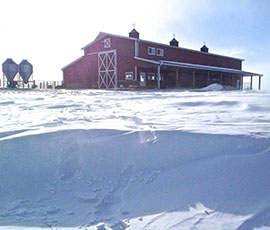USA deep freeze fails to heat up grain markets

Farmers in the USA’s major grain producing states have been facing the coldest weather in 80 years, but grain markets remain steady.
Warnings of a “dangerously cold Arctic air” moving across two thirds of the eastern states, was issued by the US government’s National Weather Service on Tuesday (7 January), with hard freeze and blizzard warnings in place. Strong gusts combined with the cold resulted in wind chills as cold as -56C.
Wheat prices had increased 6-7 cents a bushel since the cold snap, but overall European and US markets were not reacting significantly, said Jonathan Lane, trading manager at Gleadell. Traders were “not particularly worried” about the impacts of the US weather on the markets, but there might be concern if the extreme cold continued and lead to extensive winter kill of crops.
The logistics of moving grain already committed was more of an issue for US markets, said Mr Lane, which might result in a spot squeeze there. For UK farmers, there remained “nothing significant to worry about” in terms of the grain market, he said.
In Greenwood county, Kansas, beef and arable farmer Brian Hind said he didn’t think his arable crops would be badly affected, despite the wind-chill of -32C yesterday. Of more concern were farms further north where it has been colder and the north east where there has been more snow.
“Undoubtedly they are having a tougher time,” he said. Mr Hind said he suspected the real issue might be further south where it usually didn’t get as cold. “I have to wonder about the citrus crop and some of the winter wheat in Texas and Oklahoma- the impact might actually be much worse in the South.”
The damage to wheat crops in his area would have been more serious if it had been warmer and the wheat had been growing more rapidly, he said.
“Overall, aside from decreased weight gain the weather was harder on the people taking care of the cattle than it was the cattle. As long as you keep the ice chopped and plenty of feed in front of them I believe everyone has gotten along OK in my area.”
Kansas farmer Brian Hind
“I do have 25 acres (10ha) of new alfalfa that was probably killed, or at least thinned out.” However, he said he didn’t believe crops in Kansas overall would be badly damaged, although there would be some.
Mr Hind’s cattle are outdoors for the winter, but he said as long as they remained dry and out of the wind, they would be okay.
“Overall, aside from decreased weight gain the weather was harder on the people taking care of the cattle than it was the cattle. As long as you keep the ice chopped and plenty of feed in front of them I believe everyone has gotten along OK in my area.”
The biggest danger for livestock farmers will come when the ice starts to melt on ponds, said Mr Hind. He said he and other farmers had lost calves in the past that had gone through iced-up ponds.
Further to the east in central Illinois, in the Mid-West, beef and arable farmer Judi Graff experienced temperatures of -24C and a wind-chill of -34C on her farm. About 10-12 inches of snow fell there, but the harsh wind and ice have been the biggest difficulty, making it hard to get to the farm’s livestock and resulting in a 12-mile detour to access passable roads.
Freezing water meant livestock had to be moved around, but Ms Graff said she was not too worried about their corn or bean crops, as the snow was acting as a protective layer. She said the local farming community were rallying around helping each other and those stuck in the snow.
Pic courtesy of Judi Graff/Flickr
